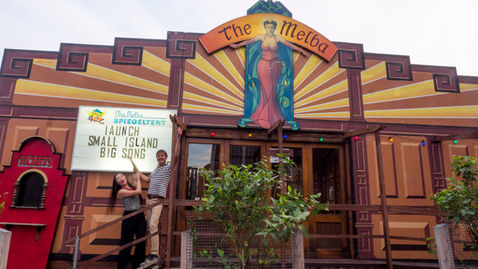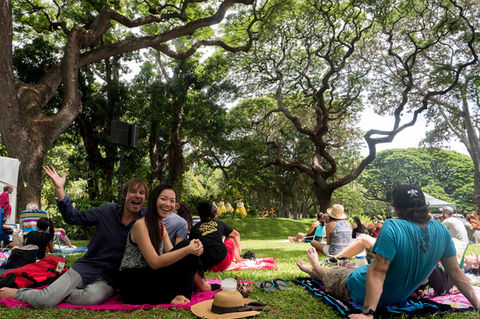
Small Island Big Song is a multi-platform project uniting the seafaring cultures of the Pacific and Indian Oceans through songs, a contemporary and relevant musical statement from a region at the frontline of the Climate Crisis.
Motivated by their concern for the ocean, Taiwanese theater producer BaoBao Chen and Australian music producer/filmmaker Tim Cole spent three years visiting artists on their homelands, recording with their guidance in nature, sharing songs from island to island. The outcomes include two award-winning albums, a feature film, edu' programs, and a live concert that has toured around the world across four continents reaching over 200K+ live audiences since the world premiere in 2018.
Small Island Big Song explores the cultural connections of the vast ocean through the Austronesian migration. Working with artists who have made a choice to maintain the cultural voice of their people, to sing in the language, and to play the instruments of their land. These unique lineages mixed with their diverse contemporary styles - roots-reggae, beats, grunge, folk & spoken-word, establishing a contemporary musical dialogue between cultures as far afield as Madagascar, Aotearoa, Taiwan, Mauritius, Papua New Guinea, Tahiti and Rapa Nui, creating "One coherent jaw dropping piece" as described by Rob Schwartz - Billboard.
Small Island Big Song was the winner of the 2019 German Record Critics’ Awards for Album of the Year and from the UK, the Songlines Music Awards 2019 for Best Asia/Pacific album and nominees for the US Independent Music Awards 2019 for Best Concept Album and Best Music Website. The album was also chosen by Lauren Laverne as "Album of the week" on BBC Radio 6.
Music critic Tom Orr has noted in the RootsWorld (US) review “….sound like one very big, very happy family doing what they do best while helping get the word out on a most serious issue.”
Songlines guide us to travel across and to live with our country
Back in late 2014, I was in Australia’s remote Central Desert listening to a faint crackling radio signal of the latest IPCC report on the BBC world service. That was after a day of recording Inmas (Songlines), with Pintupi Elders, the last Aboriginal Australians to leave their traditional nomadic lifestyle ‘The Pintupi Nine". Many of the Inmas I recorded that day were pre European contact, full of history, law and practical knowledge such as how to live and survive with country and how to structure and maintain social systems in harmony with nature.
As my heart sunk listening to that IPCC report, detailing Climate Changes effects on the Pacific Islands, a tragic irony struck me: that the very people, who do know how to live sustainably on fragile small Islands, are the first to loose theirs through the unsustainable lifestyle of the rest of us; we are going to loose the cultural knowledge we most need to hear.
With the Pintupi Elders I had experienced first hand the power of Inma, knowledge songs sung on the land, even though I didn’t understand Pintupi. It was clear to me then that I needed to offer my skills to the people of the Pacific islands to create a songline uniting and sharing their cultural knowledge; so this project was born.
The Narrative: Sharing a seafaring ancestry
From Taiwan to Aotearoa/New Zealand; From Rapa Nui to Madagascar.
When I was in Vanuatu directing ‘Vanuatu Women’s Water Music’, I discovered an incredible heritage they shared with communities spread across Asia, Pacific & Indian oceans. Most of these communities were established by the ancient seafarers. When I first learnt this back in late 2013, I thought, “What an incredible wealth of cultures, music and instruments to base an album on”.
Five millennia ago, before the pyramids of Giza were imagined, those we now call the Indigenous people of Taiwan must have been the world's most advanced society with developed technology and science, ocean going vessels, advanced navigation and transportable agricultural practices, along with a rich culture and language to unite them. In one of the most courageous and unrecognised landmark moments in Earths history, they pushed their boats out into an open horizon not knowing what or if anything lay before them. Over the following 4,000 years, following the ocean currents and stars they spread their civilisation, language, customs and musical instruments, from Taiwan to the Philippines, then voyaging throughout Southeast Asia to the furthest extremes of the Pacific Ocean and Indian Oceans. Their descendants are now the Polynesian, Micronesian, Melanesian and Torres Strait Islanders of the Pacific, the Indonesians, Malay, Filipino and Cham people of Asia, the people of Madagascar and the Indigenous Taiwanese.
Collectively known as the Austronesian, they are the worlds sixth biggest language group, with the largest diaspora footprint.

*Map of expansion of Austronesian languages. Based on the Atlas historique des migrations by Michel Jan et al. 1999 and "The Austronesian Basic Vocabulary Database" 2008
We had amazing moments when we asked artists about their language, what's the word for eyes in your language? Almost everyone said 'mata' “and how about 'hand”? “we say lima/rima”. Even numbers are similar, and that’s with 5,000 years of separation, inspiring to see!
A contemporary message
Our motivation is the steady march of environmental and cultural loss across this region, a region now divided by national politics, imposed borders, colonising languages and regional prejudices.
We have also reached a threshold that our collective lifestyles have directly effected the global environmental, at this level our planet could be viewed as a fragile Island of which we all are the responsible for.
But rather than highlighting the loss and pointing fingers, you will experience inspirational artists, singing from the depth of their heritage into a sustainable future, celebrating tradition, community and uplifting and enlightening music recorded on their homelands.
An uplifting soundtrack taking you on a voyaging journey
In the end, it's all about music, so we hope you will enjoy it as much as we did recording it with these wonderful artists on their homeland. both contemporary and traditional, poignant and playful. So please, join us on an oceanic voyage across these island communities, too precious to loose.
- Small Island Big Song producers Tim Cole & BaoBao Chen
Producers Notes
Our goal with Small Island Big Song was to create an album rich and resonant in the cultures and nature of the Pacific and Indian Oceans, so to achieve this whilst keeping our own musical prejudices aside, we came up with this method –
To ask the artist to share a song with the project which they are proud to represent their cultural heritage with, and to share with other musicians proudly identifying with their heritage. And that this song be all in your language and played on traditional instruments, or instruments which have been adopted by that culture. (So we could include the Ukulele and Kabosy, but no Guitars). We also asked each artist to choose a location to record at, a place which has meaning to them and their culture.
So we left it up to the artist decide what song to play and also what songs to add overdubs onto, and what to play although I did guide them to find rhythms and motifs from their tradition rather than adding a reggae feel for example. We were really hunting for something new, unexpected.
The producing/engineering rules –
1 – To film every take, this added an extra element into the recording the musicians were also performing and it added some tension, which wasn’t all a bad thing.
2 – All sounds had to pass through the air, no direct inputs, all acoustic instruments, it ended up not just being all acoustic Instruments, but all handmade instruments. (there is one exception – Gabagaba)
3 – Only traditional instruments could make it onto the final Songline.
4 – Only Austronesian languages (the indigenous languages of this region) could be heard on the songs.
5 – Off grid, no metronome click track, all feel driven. (There were some exceptions).
Gear –
We left Australia with the least equipment we could get away with it, to make sure there was no excess baggage and keep it manageable for the two of us.
Audio –
A field recorded with four XLR inputs and a stereo XY mic’. (thanks Miko and CAAMA Music). 1 x TLN 102 (Neumann), 1 x SM87 and a Video lapel mic’. (A year into the project I received a RODE sponsorship, 2 x NT5’s, NT1 shotgun and a stereo camera mic). But most of the recordings were done with just those three initial mic’s.
The album was mixed in the field on headphones with a Bluetooth speaker.
Video –
1 x Panasonic GH4, 1 X Cannon 550, DJI phantom 3-Pro Drone, Go Pro 4.




























